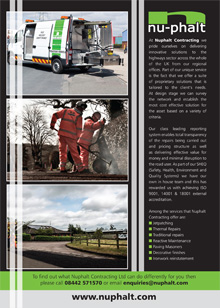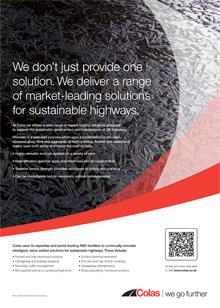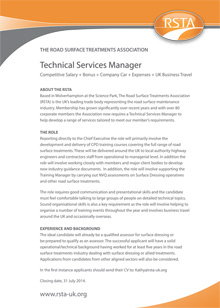eNews
Issue 12 - Spring 2014
Industry's view
MIDLANDS HIGHWAY ALLIANCE (MHA) – DRIVING COLLABORATION
Peter Barclay, Alliance Manager
The Midlands Highway Alliance (MHA) was the first partnership of its kind in the UK when we launched operations in July 2007. The aims of the Alliance are to improve performance, share best practice and make efficiency savings in the delivery of highway services in the Midlands by collaborative working.
Now self-funding, our unique venture delivers the regional procurement and implementation of highways maintenance, professional services and capital works through framework agreements. We currently have 21 members – including the Highways Agency.
As government looks to the industry to reduce its costs with its Construction Strategy, we are equipped to work with our members and the supply chain to help deliver this using work streams already in place.
The Term Maintenance work stream concentrates on the identification of efficiencies, and developing KPI’s; working with the industry is key to this being successful. It also focuses on working with local authorities and suppliers to develop an Improvement Cycle –where problems are identified and solutions implemented in order to ensure continuous improvement.
With a skills shortage in the industry, training is becoming crucial and we are developing our Skills Academy to address this. The Academy ensures both contractors and member authorities develop training and skills opportunities for their staff, the supply chain and the local community. By using industry common knowledge, the Academy can encourage collaboration and the sharing of best practice. A recent example of collaboration and sharing of best practice for MHA members and suppliers was the free ‘Surface dressing’ training course organised in partnership between RSTA and the MHA.
Savings are also being achieved through our Medium Schemes work stream – this delivers huge financial benefits to members; 60 schemes have been delivered by the framework to date with an estimate saving of 11.3%.
With regard to the road ahead from the MHA’s perspective; it is accepted that local authorities are already hard pressed due to funding cutbacks, so the shortfall in road repair and maintenance budgets is something which authorities across the country are trying to manage. Working with organisations such as the RSTA on developing preventative treatments can give significant benefits. While we understand that each authority has different ways of working, our belief is that by using standardisation and harmonisation we can help our members across the midlands to capitalise on the benefits which collaboration brings.
For more information about the MHA please visit www.mhaweb.org.uk or email: [email protected]
back to contents »
CURRENT ROAD MAINTENANCE AND ROAD SAFETY ISSUES
David Davies, Executive Director, PACTS
It seems hard to believe that as the High Speed Rail Parliamentary Bill Committee gets down to work (£50 billion) and the Road Investment Programme is fleshed out (£30-50 billion) the Government has invited local authorities in England to compete for the £168 million (yes, million) Pothole Fund to repair local roads.
There is a fundamental mismatch between the public’s desire for better maintenance of existing roads and the Government’s spending priorities which favour large new transport projects while failing to maintain existing assets. Structural maintenance, drainage systems, road and footway surfaces, and signs and lines are not maintained to anything like optimum standards from a safety, environmental, amenity or economic perspective. Previous governments are equally culpable.
These are not just the views of Mr Toad or Victor Meldrew but shared by drivers, pedestrians and users of two wheelers alike. Indeed, vulnerable road users often are the worst affected by bad road surfaces. And as road safety policy increasingly focuses on the needs of these groups (in London pedestrians, motor cyclists and pedal cyclists make up 80% of total KSI casualties) the quality of the road surface will become increasingly relevant to road safety.
The PACTS Board met recently to review its priorities in the run-up to the general election. It may or may not surprise some people to know that the Board wants to see pedestrians injured in footway trips and falls included in official road casualty statistics and a much higher priority given to footway and carriageway maintenance.
Given the public spending projections, the government taking office on 8th May 2015 is unlikely to find substantial additional funds for road maintenance. So money must be spent wisely and employed in a number of ways. Asset management systems will no doubt play an important part but I suspect they are not the panacea. I recall Lincolnshire County Council’s Highways Maintenance Best Value Review of 2001 which placed great store on such systems. There will also be a place for more familiar and less glamorous maintenance techniques. Can we make “tar spray and chip” more acceptable to the public? Fewer loose chippings?
As a London commuter cyclist, I’d like to see far better design, construction and repair of the areas around drainage gullies which are simply unable to withstand the heavy traffic loads (mainly buses). Better still, install kerb-face drainage and do away with the gullies!
back to contents »
Copyright 2014 Road Surface Treatments Association. www.rsta-uk.org










